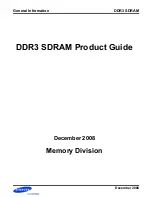
Intel® Server Board M50CYP2SB Family Technical Product Specification
42
4.2.2.1
Intel® Optane™ Persistent Memory
200 Series Module
–
Memory Mode (MM)
In Memory mode, the standard DDR4 DRAM DIMM acts as a cache for the most frequently accessed data,
while
Intel® Optane™ persistent memory 200 series modules
provide large memory capacity by acting as
direct load/store memory. In this mode, applications and operating system are explicitly aware that the Intel®
Optane™
persistent memory 200 series is the only type of direct load/store memory in the system. Cache
management operations are handled by the integrated memory controller on the Intel® Xeon® Scalable
processors. When data is requested from memory, the memory controller first checks the DRAM cache. If the
data is present, the response latency is identical to DRAM. If the data is not in the DRAM cache, it is read from
the
Intel® Optane™ persistent memory 200 series modules
with slightly longer latency. The applications with
consistent data retrieval patterns that the memory controller can predict, will have a higher cache hit rate.
Data is volatile in Memory mode. It will not be saved in the event of power loss. Persistence is enabled in App
Direct mode.
4.2.2.2
Intel® Optane™ Persistent Memory
200 Series Module
–
App Direct (AD) Mode
In App Direct mode, applications and the operating system are explicitly aware that there are two types of
direct load/store memory in the platform. They can direct which type of data read or write is suitable for
DRAM or
Intel® Optane™ persistent memory 200 series modules
. Operations that require the lowest latency
and do not need permanent data storage can be executed on DRAM DIMM
, such as database “scratch pads”.
Data that needs to be made persistent or structures that are very large can be routed to the Intel® Optane™
persistent memory. The App Direct mode must be used to make data persistent in memory. This mode
requires an operating system or virtualization environment enabled with a persistent memory-aware file
system.
App Direct mode requires both driver and explicit software support. To ensure operating system
compatibility, visit
https://www.intel.com/content/www/us/en/architecture-and-technology/optane-
4.2.2.3
Intel® Optane™ PMem configuration using the <F2> BIOS Setup Utility
Following the installation of Intel® Optane™ PMem devices into the system, th
e devices need to be
configured using the <F2> BIOS Setup utility. The BIOS Setup utility includes several Int
el® Optane™ PMem
configuration options across multiple BIOS Setup screens. The following illustration provides a BIOS Setup
screen
navigation directing the user to the main Intel® Optane™ PMem configuration screen.
Figure 23.
<F2> BIOS Setup Screen Navigation for Intel® Optane™ PMem Setup Options















































